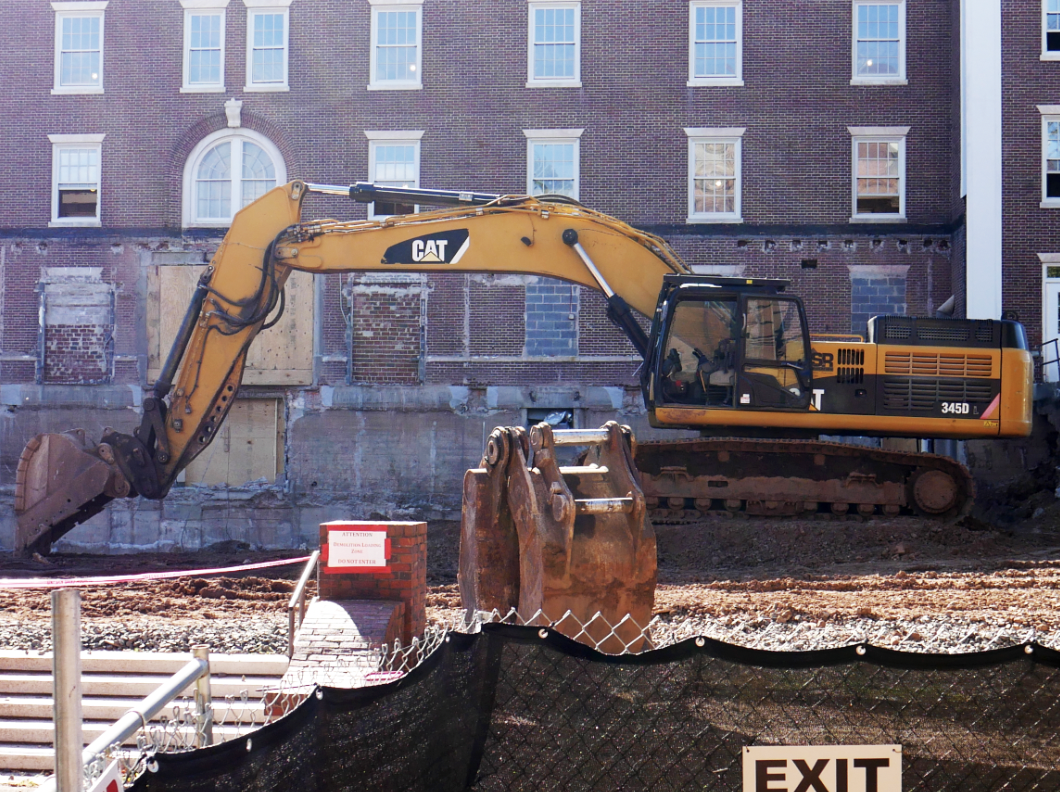
It’s hard not to notice the Center for Public Affairs (PAC) construction project. Whether you hear the noises during your ambles across Andrus, are inconvenienced by walking around Allbritton, or once considered PAC your home base, the project has altered the routines of just about every student on campus.
For many students, PAC was a place that housed many of their classes, major resources, professors’ offices, and even extracurricular activity spaces. For them, losing that space comes with a sense of nostalgia.
“There’s a lot of things that PAC does that I wish it was doing right now,” Bodhi Small ’22 said.
Nathaniel Graber ’22 echoed Small’s sentiments, highlighting the sense of sentimentality that the PAC brought.
“It’s been somewhat displacing…[because] your major is associated with certain buildings, and now our home is gone,” Graber said.
The PAC is normally home to the College of Social Studies (CSS), Economics, Government, History, and Sociology departments, all of which have been relocated into various buildings across campus, including Mount Vernon Street, Exley, and various temporary PAC swing spaces.
Project Manager in Facilities Michael Rosalie highlighted the positive aspects of the reconstruction project, noting that the new building will be more sustainable than the old one.
“When completed, the Public Affairs Center will use one-third less energy than the existing facility,” Rosalie wrote in an email to The Argus. “The construction materials and technologies for the project will highlight Wesleyan’s commitment to sustainability.”
However, some students pointed out that the environmental costs of construction may outweigh the promise of sustainability in the new building.
“If you tear down an entire building and build up an entire new one, there’s a lot of emissions related to that,” Will Wallentine ’23 said.“Would the amount of money to make that new building that is slightly more energy efficient be worth it?”
Small believes that the monetary cost of the reconstruction could have been spent in other ways.
“There’s not enough housing and people have to live in the Middletown Inn,” Small said. “It feels like there’s so many different places that need attention rather than PAC…. This could’ve been smaller scale.”
To explain why the reconstruction of PAC was a priority, Rosalie cited a campus survey from 2015. The survey suggests that PAC is currently being reconstructed with the hopes of improving dynamics between students and faculty.
“A campus wide survey of faculty and students…identified the Public Affairs Center as one of the least favorite and least flexible classroom buildings on campus with almost no space for faculty and student interaction or for student study outside of the classroom,” Rosalie wrote. “A project was undertaken beginning in 2017 to design renovations and additions to the Public Affairs Center to meet the academic and programmatic needs of the campus well into the future.”
Not all students are concerned with the PAC reconstruction. In addition to supporting the connection to sustainability and feeling positively about the project overall, Michaela Weinstein ’25 believes that students’ negative reactions to the project come from lack of knowledge about how budgeting at the University works.
“If I was one of the kids in the Inn I’d be very upset about it, but the distribution of money is much more complicated than people think it is, what they get money [donated] for, they can’t just move [it] around,” Weinstein wrote in a message to The Argus.
Despite the inconveniences posed by construction, students are optimistic about the new building and what it has to offer. While Graber has classes that have been displaced to Exley due to the construction project, he has taken advantage of this opportunity to explore new areas of campus.
“In a strange way it’s broadened my classroom horizons,” Graber said.
Additionally, Graber is looking forward to the new art gallery that will be placed between PAC and Olin, which will showcase pieces from the Davison Art Center’s (DAC) collection and student and faculty art installations. Rosalie explained the various components of the gallery space.
“The art gallery will feature a 1,400 GSF [gross square feet] display area, a security area, and storage,” Rosalie said. “The art gallery lobby will serve as an important connection from college walk through PAC, and into Olin and the DAC art archive storage and classroom space completed in 2019.”
Hannah Podol can be reached at hpodol@wesleyan.edu
Sara Mangelsdorf can be reached at smangelsdorf@wesleyan.edu


Leave a Reply